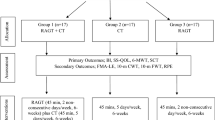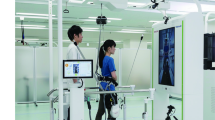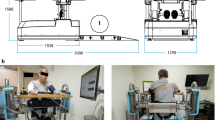Abstract
Aim
This study aims to investigate the effects of robot-assisted gait training (RAGT) frequency on walking, functional recovery, QoL and mood.
Methods
Sixty patients aged 50–75, diagnosed with post-stroke hemiplegia were entered into the retrospective analysis. Participants who scored maximum 3 on the Modified Rankin Scale and were diagnosed with moderate stroke according to The NIH Stroke Scale were included in the study. The participants in group 1 (G1) received only conventional treatment (CT), in group 2 (G2) participants received one session of RAGT per week in addition to the CT program, and group 3 (G3) received two sessions of RAGT per week in addition to the CT program. 6-min walk test (6-MWT), Barthel Index (BI), Stroke-Specific Quality of Life Scale (SSQoL), and Beck Depression Inventory (BDI) were recorded.
Results
Median change in SSQoL of G3 was significantly higher from median change of G1 (p < 0.05), and median change in BDI of G3 was significantly lower than median change of G1 (p < 0.05). Median change in BDI of G3 was also significantly lower from change of G2 (p < 0.05).
Conclusion
Two weekly sessions of RAGT in addition to CT exhibit positive effects on QoL and mood but no additional contribution to functional status.

Similar content being viewed by others
Availability of data and materials
Not applicable.
Code availability
Not applicable.
References
Rochmah TN, Rahmawati IT, Dahlui M, Budiarto W, Bilqis N (2021) Economic burden of stroke disease: a systematic review. Int J Environ Res Pub Health 18(14):7552. https://doi.org/10.3390/ijerph18147552
Marque P, Gasq D, Castel-Lacanal E, De Boissezon X, Loubinoux I (2014) Post-stroke hemiplegia rehabilitation: evolution of the concepts. Ann Phys Rehabil Med 57(8):520–529. https://doi.org/10.1016/j.rehab.2014.08.004
Li S, Francisco GE, Zhou P (2018) Post-stroke hemiplegic gait: new perspective and insights. Front Physiol 9:1021. https://doi.org/10.3389/fphys.2018.01021
Laurent K, De Sèze MP, Delleci C, Koleck M, Dehail P, Orgogozo JM, Mazaux JM (2011) Assessment of quality of life in stroke patients with hemiplegia. Ann Phys Rehabil Med 54(6):376–390. https://doi.org/10.1016/j.rehab.2011.06.002
Winstein CJ, Stein J, Arena R, Bates B, Cherney LR, Cramer SC, American Heart Association Stroke Council, Council on Cardiovascular and Stroke Nursing, Council on Clinical Cardiology, and Council on Quality of Care and Outcomes Research et al (2016) Guidelines for adult stroke rehabilitation and recovery: a guideline for healthcare professionals From the American Heart Association/American Stroke Association. Stroke 47(6):e98–e169. https://doi.org/10.1161/STR.0000000000000098
Bernhardt J, Godecke E, Johnson L, Langhorne P (2017) Early rehabilitation after stroke. Curr Opin Neurol 30(1):48–54. https://doi.org/10.1097/WCO.0000000000000404
Selves C, Stoquart G, Lejeune T (2020) Gait rehabilitation after stroke: review of the evidence of predictors, clinical outcomes and timing for interventions. Acta Neurol Belg 120(4):783–790. https://doi.org/10.1007/s13760-020-01320-7
Langhorne P, Bernhardt J, Kwakkel G (2011) Stroke rehabilitation. Lancet 377(9778):1693–1702. https://doi.org/10.1016/S0140-6736(11)60325-5
Choi S, Kim SW, Jeon HR, Lee JS, Kim DY, Lee JW (2020) Feasibility of robot-assisted gait training with an end-effector type device for various neurologic disorders. Brain Neurorehabil 13(1):e6. https://doi.org/10.12786/bn.2020.13.e6
Wallard L, Dietrich G, Kerlirzin Y, Bredin J (2015) Effects of robotic gait rehabilitation on biomechanical parameters in the chronic hemiplegic patients. Neurophysiol Clin 45(3):215–219. https://doi.org/10.1016/j.neucli.2015.03.002
Hidler J, Nichols D, Pelliccio M, Brady K (2005) Advances in the understanding and treatment of stroke impairment using robotic devices. Top Stroke Rehabil 12(2):22–35. https://doi.org/10.1310/RYT5-62N4-CTVX-8JTE
Tedla JS, Dixit S, Gular K, Abohashrh M (2019) Robotic-assisted gait training effect on function and gait speed in subacute and chronic stroke population: a systematic review and meta-analysis of randomized controlled trials. Eur Neurol 81(3–4):103–111. https://doi.org/10.1159/000500747
Mehrholz J, Thomas S, Kugler J, Pohl M, Elsner B (2020) Electromechanical-assisted training for walking after stroke. Cochrane Database Syst Rev. https://doi.org/10.1002/14651858.CD006185.pub5
Hidler J, Nichols D, Pelliccio M, Brady K, Campbell DD, Kahn JH, Hornby TG (2009) Multicenter randomized clinical trial evaluating the effectiveness of the Lokomat in subacute stroke. Neurorehabil Neural Repair 23(1):5–13. https://doi.org/10.1177/1545968308326632
Schwartz I, Meiner Z (2015) Robotic-assisted gait training in neurological patients: who may benefit? Ann Biomed Eng 43(5):1260–1269. https://doi.org/10.1007/s10439-015-1283-x
Quinn TJ, Dawson J, Walters MR, Lees KR (2009) Reliability of the modified Rankin Scale: a systematic review. Stroke 40(10):3393–3395. https://doi.org/10.1161/STROKEAHA
Goldstein LB, Bertels C, Davis JN (1989) Interrater reliability of the NIH stroke scale. Arch Neurol 46(6):660–662. https://doi.org/10.1001/archneur
Fulk GD, Echternach JL, Nof L, O’Sullivan S (2008) Clinometric properties of the six-minute walk test in individuals undergoing rehabilitation poststroke. Physiother Theory Pract 24(3):195–204. https://doi.org/10.1080/09593980701588284
Shah S (1984) Reliability of the original Brunnstrom recovery scale following hemiplegia. Austr Occup Ther J 31(4):144–151
Li F, Wu Y, Li X (2014) Test-retest reliability and inter-rater reliability of the Modified Tardieu Scale and the Modified Ashworth Scale in hemiplegic patients with stroke. Eur J Phys Rehabil Med 50:9–15
Cheng DK, Nelson M, Brooks D, Salbach NM (2020) Validation of stroke-specific protocols for the 10-meter walk test and 6-minute walk test conducted using 15-meter and 30-meter walkways. Top Stroke Rehabil 27(4):251–261. https://doi.org/10.1080/10749357.2019.1691815
Küçükdeveci AA, Yavuzer G, Tennant A, Süldür N, Sonel B, Arasil T (2000) Adaptation of the modified Barthel Index for use in physical medicine and rehabilitation in Turkey. Scand J Rehabil Med 32(2):87–92
Hakverdioğlu Yönt G, Khorshid L (2012) Turkish version of the Stroke-specific quality of life scale. Int Nurs Rev 59(2):274–280. https://doi.org/10.1111/j.1466-7657.2011.00962.x
Ilut S, Stan A, Blesneag A, Vacaras V, Vesa S, Fodoreanu L (2017) Factors that influence the severity of post-stroke depression. J Med Life 10(3):167
Pennycott A, Wyss D, Vallery H, Klamroth-Marganska V, Riener R (2012) Towards more effective robotic gait training for stroke rehabilitation: a review. J Neuroeng Rehabil 9:65. https://doi.org/10.1186/1743-0003-9-65
Srivastava S, Kao PC, Reisman DS, Scholz JP, Agrawal SK, Higginson JS (2016) Robotic assist-as-needed as an alternative to therapist-assisted gait rehabilitation. Int J Phys Med Rehabil 4(5):370. https://doi.org/10.4172/2329-9096.1000370
Bortole M, Venkatakrishnan A, Zhu F, Moreno JC, Francisco GE, Pons JL et al (2015) The H2 robotic exoskeleton for gait rehabilitation after stroke: early findings from a clinical study. J Neuroeng Rehabil 12:54. https://doi.org/10.1186/s12984-015-0048-y
Bruni MF, Melegari C, De Cola MC, Bramanti A, Bramanti P, Calabrò RS (2018) What does best evidence tell us about robotic gait rehabilitation in stroke patients: A systematic review and meta-analysis. J Clin Neurosci 48:11–17. https://doi.org/10.1016/j.jocn.2017.10.048
Bezzola L, Mérillat S, Gaser C, Jäncke L (2011) Training-induced neural plasticity in golf novices. J Neurosci 31(35):12444–12448. https://doi.org/10.1523/JNEUROSCI.1996-11.2011
Schwartz I, Sajin A, Fisher I, Neeb M, Shochina M, Katz-Leurer M, Meiner Z (2009) The effectiveness of locomotor therapy using robotic-assisted gait training in subacute stroke patients: a randomized controlled trial. PMR 1(6):516–523. https://doi.org/10.1016/j.pmrj.2009.03.009
Stinear CM, Byblow WD (2014) Predicting and accelerating motor recovery after stroke. Curr Opin Neurol 27(6):624–630. https://doi.org/10.1097/WCO.0000000000000153
Dundar U, Toktas H, Solak O, Ulasli AM, Eroglu S (2014) A comparative study of conventional physiotherapy versus robotic training combined with physiotherapy in patients with stroke. Top Stroke Rehabil 21(6):453–461. https://doi.org/10.1310/tsr2106-453
Nankaku M, Tanaka H, Ikeguchi R, Kikuchi T, Miyamoto S, Matsuda S (2020) Effects of walking distance over robot-assisted training on walking ability in chronic stroke patients. J Clin Neurosci 81:279–283. https://doi.org/10.1016/j.jocn.2020.09.067
Degami A, Taki S, Imura T, Iwamoto Y, Imada N, Tanaka R et al (2022) Early Initiation of exoskeletal robotic gait training improves functional outcomes in the patients with stroke: a retrospective observational Study. Eur Neurol. https://doi.org/10.1159/000527710
Mustafaoglu R, Erhan B, Yeldan I, Gunduz B, Tarakci E (2020) Does robot-assisted gait training improve mobility, activities of daily living and quality of life in stroke? A single-blinded, randomized controlled trial. Acta Neurol Belg 120(2):335–344. https://doi.org/10.1007/s13760-020-01276-8
Park S-Y (2015) The effects of robot-assisted gait training for the patient with post stroke: a meta-analysis. Phys Ther Korea 22(2):30–40
Straudi S, Severini G, Da Roit M, Pizzongolo LDM, Martinuzzi C, Basaglia N (2020) The dose of robot-assisted gait therapy may influence functional recovery in a multidisciplinary rehabilitation program: an exploratory retrospective study. Int J Rehabil Res 43(2):175–182. https://doi.org/10.1097/MRR.0000000000000407
Jung KH, Ha HG, Shin HJ, Ohn SH, Sung DH, Lee PK et al (2008) Effects of Robot-assisted gait therapy on locomotor recovery in stroke patients. J Korean Acad Rehabil Med 32(3):258–266
Funding
The authors did not receive support from any organization for the submitted work.
Author information
Authors and Affiliations
Contributions
Conceptualization: EY, ESB, RK, AD. Methodology: MFY, RK, ESB. Formal analyses and investigation: EY, TA. Writing—review and editing: MFY, EY. Writing—Original Draft: EY, RK, AD, TA. Supervision: MFY, RAK, TA. Data Curation: ESB, AD, RK.
Corresponding author
Ethics declarations
Conflict of interest
The authors have no conflicts of interest to declare that are relevant to the content of this article.
Ethical approval
Ethics committee approval for the study was obtained from Bolu Abant Izzet Baysal University Clinical Research Ethics Committee (No. 2022/218).
Additional information
Publisher's Note
Springer Nature remains neutral with regard to jurisdictional claims in published maps and institutional affiliations.
Rights and permissions
Springer Nature or its licensor (e.g. a society or other partner) holds exclusive rights to this article under a publishing agreement with the author(s) or other rightsholder(s); author self-archiving of the accepted manuscript version of this article is solely governed by the terms of such publishing agreement and applicable law.
About this article
Cite this article
Yakşi, E., Bahadır, E.S., Yaşar, M.F. et al. The effect of robot-assisted gait training frequency on walking, functional recovery, and quality of life in patients with stroke. Acta Neurol Belg 123, 583–590 (2023). https://doi.org/10.1007/s13760-023-02194-1
Received:
Accepted:
Published:
Issue Date:
DOI: https://doi.org/10.1007/s13760-023-02194-1




